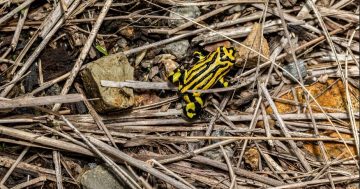
NSW Local Land Services officer Dean Freeman says a calm burn ensures small animals have time to move away from the fire, and limits the temperatures of the fire, making it easier to control. Photo: Australian National University.
A hidden treasure has emerged from the soil on a travelling stock reserve near Boorowa thanks to the use of traditional burning practices.
The discovery of a rare native species of plant by Australian National University (ANU) researchers has generated much excitement given the fact it is a listed threatened species and had never previously been detected in the area.
Listed as endangered in NSW and Victoria, more than 120 endangered small scurf-pea (Cullen parvum) were discovered after a cultural burn – conducted by NSW Aboriginal Land Council Onerwal – had taken place.
The small perennial pea bears clusters of flowers in threes, purple-pink (or sometimes white), appearing in summer, making it strikingly similar to clover.
But that’s where comparisons end; instead of the commonly known oval-shaped three or four (if you’re lucky) leaves – the small scurf pea bears three elongated leaflets about 25 mm long by 8 mm wide.
The small scurf-pea was known in NSW from only two herbarium collections; one from Wagga Wagga in 1884 and the other from Jindera (near Albury) in 1967.
But recent discoveries of populations dotted around the Riverina, on travelling stock reserves near Jerilderie and Wagga Wagga, and the NSW South West Slopes, on private land near Young, are strengthening hopes for its recovery.
Further afield, large populations have been recorded in grassy gaps in the Red Gum Woodlands of Barmah State Park, just across the border in Victoria and, according to the NSW Government’s threatened species conservation program Saving our Species (SoS), extensive suitable habitat probably occurs across the border in NSW.
This Boorowa population is the most northern and eastern population now on record in Australia.

This Boorowa population is the most northern and eastern population of small scurf-pea now on record in Australia. Photo: Saving our Species, NSW Government.
To safeguard the future of this threatened species, threat management plans are in place for the sites with seeds collected and preserved at the Botanic Gardens of Sydney’s Australian PlantBank at Mt Annan.
But the find reinforces the endeavours of a larger project involving SoS, the ANU’s Fenner School of Environment & Society and a cohort of NSW Local Aboriginal Land Councils including Onerwal, Young and Wagga Wagga.
The collaboration involves the reintroduction of cultural burning in box-gum grassy woodlands to monitor the environmental outcomes of the burns.
During 2023, local Ngunnawal and Wiradjuri community members led cultural burns on their respective Countries and 40 community members were sponsored to gain firefighting and safety training with the NSW Rural Fire Service.
Cultural burning is when First Nations people use fire to manage the landscape in a way that benefits the whole ecosystem, using traditional knowledge to care for Country.
NSW Local Land Services officer Dean Freeman says a calm burn ensures small animals have time to move away from the fire, and limits the temperatures of the fire, making it easier to control.
The fire from the lower intensity burn triggers new growth, without the destruction of a fast, extremely hot fire.
Importantly, it also aims to reduce the impact of bushfires on the ecosystem.
As well as the environmental benefits, cultural burning has multiple dimensions for First Nations practitioners: it is spiritual, cultural and social.
“Our environment has depended on fire for thousands and thousands of years,” says Bradley Bell, a Ngunnawal Traditional Custodian who practises cultural burning.
“Many Australians understandably see fire only as a danger, based on collective experiences of devastating bushfires,” he said, “but if used in the right way, fire can also be a tool that benefits the landscape and reduces the impact of bushfires themselves.”
It’s also a way to share knowledge across generations, as Mr Bell has done with his son, Braithan.
“I think bringing two really strong knowledges together is the best way of moving forward,” Braithan says.
“We have a strong, intangible connection to our Country and we see Country from a different perspective, but how western science collects and coordinates that data is really interesting for me.”
Dr Elle Bowd from the ANU Fenner School of Environment and Society, who is leading the research alongside Professor David Lindenmayer, says the university’s research is tracking how the environment compares before and after cultural burning takes place.
She said discoveries of small scurf pea were very rare.
“It was a great outcome to find them germinating after the cultural burn – the species seed was in the soil waiting for this opportunity,” she said.
“These systems have been unburnt for hundreds of years, so it’s critically important to monitor how they respond to the reintroduction of these kinds of practices so we can inform future monitoring programs,” Dr Bowd says.
The science backs up the work First Nations people have been doing, and will continue to do, for generations to come, she said.
You can donate to this project at the Cultural burning in endangered grassy woodland fund.





